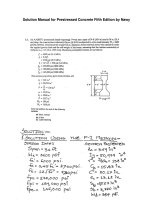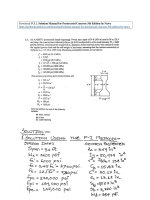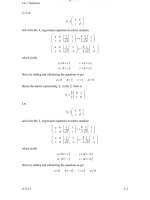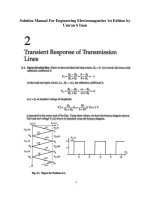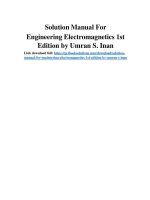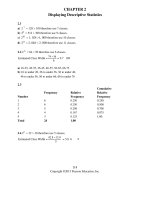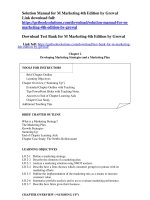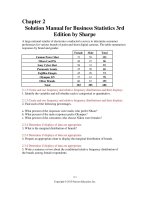Solution manual for ACCT2 financial 2nd edition by tyler
Bạn đang xem bản rút gọn của tài liệu. Xem và tải ngay bản đầy đủ của tài liệu tại đây (376.72 KB, 46 trang )
.
Chapter 1
Financial accounting
Table of contents
Chapter overview
Key concepts
Learning objectives
Lecture outline
Answers for end-of-chapter exercises
Answers for end-of-chapter problems
Enrichment modules:
Exercises
Problems
Cases
Enrichment module solutions:
Exercises
Problems
Cases
Chapter overview
To understand the financial health of a business, one needs to understand the language
of business, and that language is accounting. The more eloquent you are in accounting,
the better you will be able to understand business health. Keeping this overall purpose
in mind, this chapter introduces the basic terms, principles and rules of accounting that
constitute the grammar of accounting.
Full file at
Key concepts
Accounting information is generated based on four basic assumptions: economic
entity assumption, time period assumption, monetary unit assumption and going
concern assumption.
The income statement (more correctly called the statement of comprehensive
income, and sometimes referred to as the profit and loss statement) is of
paramount importance because it depicts the performance of a business over a
period of time. (Students should be aware that the nouns we use in accounting
vary between countries, textbooks and, as we will see, financial reports of
Australian companies. Students need to get used to different terms being used
for the same items.)
A balance sheet (sometimes called the statement of financial position) is a
snapshot of a business, as it shows the financial position at a particular point in
time. (The ‘equity’ section is sometimes called ‘shareholders equity’, and the
amount contributed by the owners ‘contributed capital’ or ‘ordinary shares’. The
latter is sometimes even referred to as ‘common stock’.)
The statement of changes in equity is the nexus between income statement
and the balance sheet. (We are concerned with the statement of retained
earnings part.)
The cash flow statement is critical because it answers where the cash is
generated from and how it has been utilised during a particular period of time.
Mere quantity of accounting information is of no use, since it is the quality that
adds efficacy to it.
The conceptual framework of accounting is the collection of concepts that
guides the manner in which accounting is practised.
Learning objectives
LO1: Examine the four assumptions made when communicating accounting
information.
LO2: Describe the purpose and structure of an income statement and the terms and
principles used to create it.
LO3: Describe the purpose and structure of a balance sheet and the terms and
principles used to create it.
© Cengage Learning Australia 2016
Full file at https://./Solution-Manual-for-ACCT2-Financial-2nd-Edition-by-Tyler
2
Solution Manual for ACCT2 Financial 2nd Edition by Tyler
LO4: Describe the purpose and structure of a statement of changes in equity and how
it links the income statement and the balance sheet.
LO5: Describe the purpose and structure of a cash flow statement and the terms and
principles used to create it.
LO6: Question the qualitative characteristics that make accounting information useful.
LO7: Study the conceptual framework of accounting.
Lecture outline
LO1: Basic accounting assumptions
Economic entity assumption: The financial activities of the business need to
be separated from the financial activities of its owner.
Example: Contributions made by the owner into the business are treated as his or
her capital, which is nothing but an internal liability for the business.
Time period assumption: Accounting information can be communicated
effectively over short periods of time.
Example: Most companies report their financial performance and position on a
quarterly, half-yearly and annual basis.
Monetary unit assumption: The dollar, unadjusted for inflation, is the best
means of communicating accounting information in Australia.
Example: The quality of service, the morale of employees and the health of
the owner cannot be quantified in terms of money.
Going concern assumption: A company will continue to operate into the
foreseeable future.
Example: All fixed assets are shown at their cost (net of accumulated
depreciation), but not at their liquidation values.
Key concept
Accounting information is generated based on four basic assumptions:
1. economic entity assumption
2. time period assumption
3. monetary unit assumption
4. going concern assumption.
© Cengage Learning Australia 2016
Full file at https://./Solution-Manual-for-ACCT2-Financial-2nd-Edition-by-Tyler
3
Solution Manual for ACCT2 Financial 2nd Edition by Tyler
Full file Tyler
at htA.by-Tyler
Teaching tip
Ask students to analyse the financial statements of a company and identify the
implications of the four basic assumptions.
LO2: Reporting profitability: the income
statement
Revenue is an increase in resources resulting from the sale of goods or the
provision of services; for example, sales revenues or investment incomes.
Revenue recognition principle: Revenues are recognised when they are earned.
Expense is a decrease in resources resulting from the sale of goods or the
provision of services; for example, the cost of goods sold or interest expense.
Matching principle: Profit for a particular period is a function of the revenues and
expenses of that period. Thus, profit for a particular period is found out by
matching the expenses against the revenues of the same period.
An income statement is a financial statement that shows a company’s revenues
and expenses over a specific period of time. (The ‘comprehensive’ part of the
statement is beyond what we consider in the earlier chapters of the text.)
Key concept
The income statement is of paramount importance as it depicts the performance of a
business over a period of time.
Key formula
Revenues – Expenses = Net Profit or Net Loss (Net Income or Income)
Teaching tip
A magazine publisher sells two-year subscriptions. Ask students whether the
publisher will treat this as revenue on the date of the transaction. Why or why
not?
A shipbuilding company uses 500 tonnes of steel in the month of January to build
a ship that will be delivered 30 months from now. Ask students to explain the
treatment of January’s expenses using the matching principle.
© Cengage Learning Australia 2016
Full file at https://./Solution-Manual-for-ACCT2-Financial-2nd-Edition-by-Tyler
4
Solution Manual for ACCT2 Financial 2nd Edition by Tyler
Full file Tyler
at htA.by-Tyler
LO3: Reporting financial position: the balance
sheet
The balance sheet is a snapshot of a business, giving a clear picture of what the
business owns and owes at a particular point in time.
Assets are an economic resource that are objectively measurable, that result
from a past transaction and that will result in future economic benefits. Examples
include merchandise inventory and equipment.
Historical cost principle: Assets are recorded in the books at the cost of their
acquisition.
Liabilities are an obligation of a business that result from past transactions and
will require sacrifice of economic resources at a future date. Examples include
accounts payable and salary payable.
Equity is the difference between the company’s assets and liabilities, and
represents the share of assets that is claimed by the owners. This relationship
among assets, liabilities and equity is reflected in the fundamental accounting
equation:
Contributed capital represents the resources that investors invest in exchange
for ownership interest.
Dividends (or drawings for a sole trader) are profits distributed to the owners.
Retained earnings are profits retained in the business.
Key equation
Assets = Liabilities + Equity
Key concept
The balance sheet is a snapshot of a business; it shows the financial position of the
business at a particular point in time.
Teaching tip
Ask students to categorise the following into asset, liability, revenue and expense:
Advance received from customers
Services rendered but fees not yet received
Insurance premium for next quarter paid in this quarter
Leased machine (you may prefer to leave this one to later).
© Cengage Learning Australia 2016
Full file at https://./Solution-Manual-for-ACCT2-Financial-2nd-Edition-by-Tyler
5
Solution Manual for ACCT2 Financial 2nd Edition by Tyler
Full file Tyler
at htA.by-Tyler
LO4: Reporting equity: the statement of
retained earnings
The statement of retained earnings shows the change in a company’s retained earnings
over a specific period of time. The basic structure of the statement is as follows:
xxxx
Opening balance of retained earnings
Add/Less: net profits / (Loss) [income]
xxx
Less: dividend (drawings)
Closing balance of retained earnings
xx
xxxx
Key concept
The statement of retained earnings is the nexus between income statement and
balance sheet.
Teaching tip
Ask students to figure out the impact of the following situations on closing
retained earnings balance:
a. Company incurred net loss during the year.
b. Company pays dividend, dividend payout being the same as last year.
Will the closing balance in the retained earnings account always be less than the
beginning balance? Ask students to substantiate their answer using two
scenarios.
LO5: Reporting cash flows: the statement of
cash flows
The statement of cash flows reports a company’s inflows and outflows of cash
from its operating, investing and financing activities over a period of time.
Operating cash flows involve cash flows arising out of central activities of a
business. Examples include receipts from customers and payments to suppliers,
employees, etc. They are the cash flows associated with revenues and expenses.
Cash flows from investing activities involve cash flows arising mainly out of the
purchase and sale of fixed assets. Examples include the purchase and sale of
© Cengage Learning Australia 2016
Full file at https://./Solution-Manual-for-ACCT2-Financial-2nd-Edition-by-Tyler
6
Solution Manual for ACCT2 Financial 2nd Edition by Tyler
Full file Tyler
at htA.by-Tyler
land, buildings, machinery, etc.
Cash flows from financing activities involve cash flows arising out of sourcing
and repaying cash. Examples include raising a loan from a bank and repaying the
same.
The basic structure of a cash flow statement is as follows:
Cash flows provided/used by operating activities
Add/Less: Cash flows provided/used by investing activities
Add/Less: Cash flows provided/used by financing activities
Net increase/decrease in cash
xxxx
xxxx
xxxx
xxxx
Key concept
An important issue for any business is its management of cash. Where does a company
get its cash? Where does its cash go? Will there be enough cash to pay the bills?
Teaching tip
Ask students to classify the following items as financing, operating, and investing
activities as they appear on the statement of cash flows:
legal fees received by a law firm
the cost of setting up interiors in an office building
the issue of bonds (debentures) for cash or simply obtaining a loan.
LO6: Qualitative characteristics of accounting
information
Understandability refers to the ability of accounting information to be
comprehensible to users who are willing to study the information with reasonable
diligence.
Relevance refers to the capacity of accounting information to make a difference
in decisions. This capacity comes from:
feedback value (the ability to assess past performance)
predictive value (the ability to predict future performance)
timely availability of information.
Reliability refers to the extent to which accounting information can be depended
upon to represent what it purports to represent. For information to be reliable, it
© Cengage Learning Australia 2016
Full file at https://./Solution-Manual-for-ACCT2-Financial-2nd-Edition-by-Tyler
7
Solution Manual for ACCT2 Financial 2nd Edition by Tyler
Full file Tyler
at htA.by-Tyler
needs to be:
verifiable
representative of truthfulness
neutral.
Comparability refers to the ability of accounting information to be used for interfirm comparisons. However, comparability does not mean uniformity.
Example: Company A and Company B belong to the same industry and both follow
the same accounting methods. Their operating results could be compared to
determine which company is doing better.
Consistency refers to the ability of accounting information to be used for intrafirm comparisons over time. To be consistent, companies need to use the same
accounting methods year after year.
Example: A company that uses the straight-line method of depreciation should
continue to do the same, year after year, unless a change is warranted.
Materiality refers to the threshold at which financial items begin to affect
decision-making. However, the threshold varies across entities and settings. The
materiality threshold is not always solely a function of dollar amounts. It also
depends on the nature of the item.
Example: The cost of a stapler can be expensed (even though it is a long–term
asset) because the amount is immaterial and will not affect anyone's decisionmaking. On the other hand, the discovery of even a small bribe or theft can be
very important and material.
Conservatism refers to the manner in which accountants deal with uncertainty
regarding economic situations. The essence of conservatism is to account for all
probable losses, but never account for probable gains.
Example: The valuation of closing inventory at cost price or market price –
whichever is lower.
Key concept
A mere quantity of accounting information is of no use, since it is the quality that adds
efficacy to the information.
Teaching tip
Take up the following questions for classroom discussion:
How logical would a comparison between two companies be if each were
following a different set of accounting methods?
© Cengage Learning Australia 2016
Full file at https://./Solution-Manual-for-ACCT2-Financial-2nd-Edition-by-Tyler
8
Solution Manual for ACCT2 Financial 2nd Edition by Tyler
Full file Tyler
at htA.by-Tyler
How relevant would an old annual report be for a shareholder contemplating a
revision of his or her portfolio?
LO7: The conceptual framework
The conceptual framework of accounting refers to the collection of concepts that guide
the manner in which accounting is practised.
Key concept
The conceptual framework of accounting is the collection of concepts that guide the
manner in which accounting is practised.
Teaching tip
Think of an accounting environment devoid of any conceptual framework to fall back
upon. Ask students to identify the problems that accountants might face while working in
such an environment.
Solutions for end-of-chapter material
End-of-chapter numerical problems have been provided to illustrate the concepts
explained in the chapter. The end-of-chapter exercises will facilitate better
understanding of the conceptual framework of basic financial accounting. Theoretical
and numerical exercises based on the chapter learning objectives are provided for
practice and clarity.
Exercises
Exercise 1. Calculate profit or loss
4 000 – 1 500 – 200 – 50 = 2 250
Teaching tip
Profit is the most import aspect of a business. In simple terms, i is revenue minus
expenses; but it becomes more complex when we have to determine what are the
revenues and expenses. The first complexity is cash versus accrual accounting. From
the outset, we recognise revenues when they are earned and expenses when they are
© Cengage Learning Australia 2016
Full file at https://./Solution-Manual-for-ACCT2-Financial-2nd-Edition-by-Tyler
9
Solution Manual for ACCT2 Financial 2nd Edition by Tyler
Full file Tyler
at htA.by-Tyler
incurred, even though the corresponding cash flow may occur before or after the fact.
Sometimes it happens simultaneously, but it does not have to.
Helpful hint for students
The income statement is ‘Really Easy’, since it reports the company’s Revenues less
Expenses. Revenues are earnings from doing business (not contributions from the
owners or borrowings). Expenses are costs of doing business (not repayments to
people you borrowed from or dividends (drawings) paid to owners).
Exercise 2. Calculate equity
$4 000
Teaching tip
It is the basic accounting equation:
A
=
10 000
L
+
6 000
E
4 000
Helpful hint for students
The things you ‘own’ (assets) have come from money borrowed (liabilities) and the
money you have put in, or contributed (the equity).
Or, to think of it another way: you are worth the difference between what you own less
what you owe.
A
–
10 000
L
=
6 000
E
4 000
Exercise 3. Identify accounting principles
1. Cost principle. We record items at cost. This saves the subjective opinion of what
they are ‘worth’. It may also include conservatism in not anticipating profits.
2. Matching principle or time period concept. We record revenue when earned and
match it to the period in which it was earned – I would not be too concerned about
having a single correct answer but it is useful to see how these concepts work together.
3. Matching principle/time period concept. As above, this applies for both revenues and
expenses.
© Cengage Learning Australia 2016
Full file at https://./Solution-Manual-for-ACCT2-Financial-2nd-Edition-by-Tyler
10
Solution Manual for ACCT2 Financial 2nd Edition by Tyler
Full file Tyler
at htA.by-Tyler
Exercise 4. Calculation of retained earnings
$175 000 + 110 000 – 10 000 = 275 000
Teaching tip
Opening balance of retained earnings + Profits – Dividends = Closing retained earnings
Retained earnings are earnings (profits) that have been retained (kept in the business).
Dividends are profits that have been distributed (not retained).
Helpful hints for students
The purpose of accounting is to identify, measure and communicate economic
information about a particular entity to interested users. To accomplish this, accountants
make the following four assumptions:
a. economic entity
b. time period
c. monetary unit
d. going concern.
Think about how each assumption affects accounting:
Why the monetary unit assumption? If an economic activity cannot be expressed
in dollars, then it is not recorded in the accounting system.
Why the economic entity assumption? It allows a user to examine a company’s
accounting information without concern that the information includes the personal
affairs of the owner(s).
Why the time period assumption? Business owners and other interested parties
usually do not want to wait long before they receive information on how a
business is doing.
Why the going concern assumption? Unless there is evidence to the contrary,
most companies are assumed to be going concerns. Those that are not going
concerns are often in the process of liquidation.
Exercise 5. Calculate cash flow
Beginning balance
175 000
Cash flows from operating
680 000
Less: cash flows to investing
(516 000)
Less: cash flows to financing
(98 000)
© Cengage Learning Australia 2016
Full file at https://./Solution-Manual-for-ACCT2-Financial-2nd-Edition-by-Tyler
11
Solution Manual for ACCT2 Financial 2nd Edition by Tyler
Full file Tyler
at htA.by-Tyler
Net change in cash—increase
$241 000
Teaching tip
Cash flows from operations and profits are different, and at this stage, it may be difficult
for students to understand why. The simplest example may be to explain that, while
revenue earned by them today may be their wages from the job they work, they don’t
get the money until pay day – so revenue and cash inflow from operations are different.
Helpful hint for students
Cash flows are divided into three areas. operations (which usually produce cash – but
cash flows from operations are not profit), financing (where we get our money from –
but it may result in a cash outflow because of loan repayments or payments like
dividends to owners) and investing (buying long-term assets).
Exercise 6. Assumptions and qualitative
characteristics
1. Going concern. (Assume a company will continue to operate into the foreseeable
future.)
2. Relevance. (The information is likely to influence or change a decision.)
3. Consistency. (Allows current results to be compared with past results. A good
analogy is world-record runners having to record their times with minimum wind
assistance, since if the wind is blowing too strongly, they will not be consistent with
past attempts and records.)
4. Materiality. (Linked to relevance – if the amount is so small that it will not influence a
decision, then it may be ignored.)
Teaching tip
Accounting information must possess certain qualitative characteristics to be considered
useful. Do not get consistency and comparability confused. Consistency applies to the
same company; comparability applies to different companies.
With materiality, we must always be careful of a number of small amounts being
ignored (and adding up to a larger amount that is relevant). One of the great ‘urban
myth’ frauds is about the employee who took a fraction of every cent paid on interest on
accounts. This was supposed to work because when there are millions of accounts
paying interest each day, you only need .25 of a cent from 10 million accounts to give
$25,000 a day – material for most of us.
© Cengage Learning Australia 2016
Full file at https://./Solution-Manual-for-ACCT2-Financial-2nd-Edition-by-Tyler
12
Solution Manual for ACCT2 Financial 2nd Edition by Tyler
Full file Tyler
at htA.by-Tyler
Helpful hints for students
Consider how each characteristic impacts accounting.
Going concern does not mean the company will continue forever (or even to the
end of the next year, if major unexpected events – a global financial crisis or a
natural disaster – happens that removes the basis of the business). It is the
basis of preparing the financial statements. Take a pair of your shoes – what
could they sell for compared what they are worth to you (as a going concern)?
Relevance: Information should have predictive or feedback value, and should be
timely.
Materiality: When an amount is small enough, normal accounting procedures
are not always followed.
Conservatism: An entity should choose accounting techniques that guard
against overstating revenues or assets.
Comparability: Entities must disclose the accounting methods that they use so
that comparisons across companies can be made.
Exercise 7. Accounting terms
Item:
1 Salaries expense
2 Equipment
3 Cash
4 Accounts payable
5 Buildings
6 Contributed capital
7 Retained earnings
8 Interest revenue
9 Advertising expense
Appears on:
Income statement
Balance sheet
Balance sheet
Balance sheet
Balance sheet
Balance sheet
Balance sheet
Income statement
Income statement
Classified as:
Expense
Asset
Asset
Liability
Asset
Equity
Equity
Revenue
Expense
Teaching tip
Remind students that the account ‘retained earnings’ also appears on the statement of
retained earnings. Contributed capital is a part of equity, since it represents resources
that investors contribute to a business in exchange for an ownership interest. Revenues
are increases and expenses are decreases in resources, resulting from the sale of
goods or the provision of services. An asset is a resource of a business; a liability is an
© Cengage Learning Australia 2016
Full file at https://./Solution-Manual-for-ACCT2-Financial-2nd-Edition-by-Tyler
13
Solution Manual for ACCT2 Financial 2nd Edition by Tyler
Full file Tyler
at htA.by-Tyler
obligation of a business; and equity is the difference between a company’s assets and
liabilities, which represents the remaining share of assets for the owners.
Helpful hint for students
Contributed capital is not a revenue account. Revenue accounts normally include the
word revenue, income, or earned in the account name, but can also be a single word
such as sales. Expenses normally include the word expense in the account name, and
occasionally can represent several accounts such as cost of sales. Liabilities normally
include the word payable.
Exercise 8. Classify cash flow
Item
Cash paid to suppliers
Section of cash
flow statement
Operating
Cash received from new shares
Financing
Cash paid for new equipment
Investing
Cash paid for dividend
Financing
Cash received from customers
Operating
Teaching tip: why?
Cash paid for operations
Cash generated from owners
Cash paid for assets (other than
current assets)
Cash paid to owners who originally
finance the business through buying
shares
Cash generated from operations
Teaching tip
The statement of cash flows is a financial statement that reports an entity’s sources
(inflows) and uses of cash (outflows) over a specific period of time. Profits that are
distributed to owners are called dividends. Remember that dividends are not an
expense of the company, and are therefore not included in cash flow from operations.
They are simply a distribution of company assets to owners.
Helpful hint for students
The buying and selling of assets other than current assets, such as land, building, and
equipment, are considered to be investing activities. Think of this as the company
‘investing in itself.’
© Cengage Learning Australia 2016
Full file at https://./Solution-Manual-for-ACCT2-Financial-2nd-Edition-by-Tyler
14
Solution Manual for ACCT2 Financial 2nd Edition by Tyler
Full file Tyler
at htA.by-Tyler
Exercise 9. Accounting terms
a.
b.
c.
d.
e.
Y/S
B/S
CF
B/S
SRE
f. CF
g. B/S
Teaching tip
Each financial statement reports specific types of accounts or activity. An income
statement is a financial statement that shows a company’s revenues and expenses over
a specific period of time. A balance sheet reports a company’s assets, liabilities and
equity. The statement of retained earnings reports the change in a business’s retained
earnings over a specific period of time, so it reports dividends and net income (or loss).
A statement of cash flows reports a company’s cash inflows and outflows from its
operating, investing and financing activities.
Helpful hint for students
The income statement is ‘Really Easy’ since it reports the company’s Revenues and
Expenses. Expenses are costs of doing business. Assets are items of value and worth;
liabilities are what a company owes; and equity is what is left over for the owners. The
statement of cash flows reports the sources of cash and the payments of cash during a
period. Remember that, since cash is in the name of the statement, all transactions
must directly relate to the inflow or outflow of cash.
Teaching tip
Remind students that the account ‘retained earnings’ also appears on the statement of
retained earnings. Contributed capital (ordinary shares) is part of equity, since it
represents resources that investors contribute to a business in exchange for an
ownership interest.
© Cengage Learning Australia 2016
Full file at https://./Solution-Manual-for-ACCT2-Financial-2nd-Edition-by-Tyler
15
Solution Manual for ACCT2 Financial 2nd Edition by Tyler
Full file Tyler
at htA.by-Tyler
Helpful hint for students
‘Sales’ is a revenue account. An expense is a cost of doing business; therefore, cost of
sales is reported on the income statement.
Exercise 10. Financial statements
Shareholder: (CI) Income statement (income statement). The shareholder would
look at the revenues on the income statement to determine how this year’s sales
figures compared with last year’s sales figures.
Banker: (FP) Balance sheet (balance sheet). The banker would look at the
liabilities on the balance sheet to find out how much debt the company had on its
books.
Supplier: (FP) Balance sheet. The supplier would look at the liabilities on the
balance sheet to determine how much the company owed its suppliers in total.
Shareholder: (CE/CF) Statement of retained earnings. The shareholder could
find the amount paid for dividends shown as a reduction on the statement of
retaining earnings. Also, the shareholder could find this amount on the statement
of cash flows under ‘Cash flows from financing’.
Advertising agent: (CI) Income statement. The advertising agent could look under
the expenses on the income statement to find out how much was used in
advertising to generate sales.
Banker: (CI/CF) Income statement. The banker could look under expenses on
the income statement to find out what the company’s total interest cost was last
year. Also, the banker could find this amount on the statement of cash flows
under ‘Cash flows from operations’.
Teaching tip
Each financial statement reports specific types of accounts or activity. An income
statement is a financial statement that shows a company’s revenues and expenses over
a specific period of time. A balance sheet reports a company’s assets, liabilities and
equity. The statement of retained earnings reports the change in a business’s retained
earnings over a specific period of time, so it reports dividends and net income (or loss).
© Cengage Learning Australia 2016
Full file at https://./Solution-Manual-for-ACCT2-Financial-2nd-Edition-by-Tyler
16
Solution Manual for ACCT2 Financial 2nd Edition by Tyler
Full file Tyler
at htA.by-Tyler
Helpful hint for students
The income statement is ‘Really Easy’ since it reports the company’s Revenues and
Expenses. Assets are items of value and worth, liabilities are what a company owes and
the equity is what is left over for the owners.
Exercise 11. Profit or loss and retained earnings
Profits = Revenue – Expenses
Profits = $10 000 – $8 000
Profits = $2 000
Retained earnings = Beginning retained earnings + Profits (or minus loss) – Dividends
Retained earnings = $20 000 + $2 000 – $1 000
Retained earnings = $21 000
Hints: Profits increase retained earnings; losses decrease retained earnings; dividends
reduce retained earnings (dividends are earnings that are not retained).
Exercise 12. The accounting (balance sheet) equation
a. Beginning of year: ($50 000 Assets = $40 000 Liabilities + ? Equity)
Equity = $10 000
Beginning equity $10 000 + $12 500 profits – $0 div. = $22 500 ending equity.
b. End of year: (? Assets = $50 000 Liabilities + $30 000 Equity)
Assets= $80 000
If Tania Ltd doubled its assets during the year, then it must have started the year
with $40 000. ($80 000 ÷ 2 = $40 000)
c. Beginning of year: ($40 000 Assets = ? Liabilities + $20 000 Equity)
Liabilities = $20 000
If liabilities tripled during the year, then Hudson has $60 000 in liabilities at the end
of the year. ($20 000 × 3 = $60 000)
© Cengage Learning Australia 2016
Full file at https://./Solution-Manual-for-ACCT2-Financial-2nd-Edition-by-Tyler
17
Solution Manual for ACCT2 Financial 2nd Edition by Tyler
Full file Tyler
at htA.by-Tyler
Teaching tip
The relationship between assets, liabilities and equity is represented by the accounting
equation: Assets = Liabilities + Equity. Using your knowledge of the accounting
equation, you can solve for the missing amounts by making it a simple mathematical
problem.
Helpful hint for students
The accounting equation (Assets = Liabilities + Equity) is like any mathematical
equation. It will always be equal (or balance). It can be rewritten in several forms, such
as: Assets – Liabilities = Equity, or Assets – Equity = Liabilities.
Exercise 13. Retained earnings
First, calculate ending retained earnings at 31 January, which is equal to beginning
retained earnings at 1 February.
1 Jan. Retained earnings
Add: Profits($80 000 – $85 000)
Less: Dividends
31 Jan. Retained earnings
$245 800
(5 000)
0
$240 800
Chan Company
Statement of retained earnings
For the month ending 28 February
1 Feb. Retained earnings
Add: Profits*
Less: Dividends
28 Feb. Retained earnings
$240 800
22 000
(7 000)
255 800
*Profits = Revenue – Expenses = $102 000 – $80 000 = $22 000
Teaching tip
The financial statements are interrelated. The income statement is prepared first. Use
the profit or loss from the income statement when preparing the statement of change in
equity (retained earnings).
© Cengage Learning Australia 2016
Full file at https://./Solution-Manual-for-ACCT2-Financial-2nd-Edition-by-Tyler
18
Solution Manual for ACCT2 Financial 2nd Edition by Tyler
Full file Tyler
at htA.by-Tyler
Helpful hint for students
The income statement is ‘Really Easy’, since it reports the company’s Revenues and
Expenses. Expenses are costs of doing business. A simple way to remember the
statement of retained earnings is ‘BIDE’: Beginning retained earnings, plus net Income
(profit or less loss), less Dividends equals Ending retained earnings.
Exercise 14. Links between financial statements
Tip: work this problem in reverse. Begin with (e).
(e)
Retained earnings, beginning balance
+Profits
–Dividends
=Retained earnings, ending balance
$20 000
(e) 50 000
10 000
$60 000
(d) Profits or Loss = $50 000
(c)
Sales
– Cost of sales
– Administrative expenses
=Profits
$90 000
(c) 20 000
(20 000)
$50 000
(b) Retained earnings = $60 000 (from statement of retained earnings)
Total liabilities and shareholders’ equity
– Total liabilities
= Total shareholders’ equity
(a)
Ordinary shares
+Retained earnings
=Total equity
$70 000
(7 000)
$63 000
(a) $3 000
60 000
$63 000
Teaching tip
A balance sheet reports a company’s assets, liabilities and equity. This relation between
assets, liabilities and equity is represented by the accounting equation: Assets =
Liabilities + Equity. Notice that the profit from the income statement is the missing
amount of profit (or loss) on the statement of retained earnings. Also, the ending
balance on the statement of retained earnings is the same amount as the retained
earnings reported on the balance sheet.
© Cengage Learning Australia 2016
Full file at https://./Solution-Manual-for-ACCT2-Financial-2nd-Edition-by-Tyler
19
Solution Manual for ACCT2 Financial 2nd Edition by Tyler
Full file Tyler
at htA.by-Tyler
Helpful hint for students
Work this problem in reverse. Using your knowledge of the accounting equation and the
interrelationship among the financial statements, you can work out the missing amounts
by making it a simple mathematical problem.
Exercise 15. Qualitative characteristics
1. Understandability: The ability to comprehend the financial activities by a person
who has a reasonable understanding of business and is willing to study the
information with reasonable diligence.
2. Relevance: The capacity of accounting information to make a difference in
decisions.
3. Reliability: The extent to which accounting information can be depended upon.
4. Consistency: The ability to compare or contrast the financial activities of the same
entity over time.
5. Materiality: The threshold at which a financial item begins to affect decisionmaking.
6. Conservatism: The manner in which accountants deal with uncertainty regarding
economic situations.
Exercise 16. Assumptions and principles
a. Cost principle: Assets should be reported at historical cost.
b. Time period assumption: An entity cannot randomly change its time period. This
also violates ‘consistency.’ An entity should use the same accounting methods year
to year and disclose when they change methods.
c. Economic entity assumption: Personal affairs of owners should be kept separate
from business affairs.
d. Revenue recognition principle: Revenue should be recorded in the period during
which it is earned.
Teaching tip
Principles, assumptions and qualitative characteristics are necessary to communicate
the financial activities and position of a business and to help ensure that accounting
information is indeed useful. Revenue is earned when the sale of the good or the
© Cengage Learning Australia 2016
Full file at https://./Solution-Manual-for-ACCT2-Financial-2nd-Edition-by-Tyler
20
Solution Manual for ACCT2 Financial 2nd Edition by Tyler
Full file Tyler
at htA.by-Tyler
provision of the service is substantially complete and collection is reasonably assured; it
is not dependent on the receipt of cash.
Helpful hint for students
Economic entity assumption: We do not have to worry that the financial information of
the owner is mixed with the financial information of the business. Remember that the
receipt of cash is not required to record revenue; we focus on when it is earned (i.e., the
company has a right to it).
Problem 17. Prepare financial statements
Revenues and expenses are listed in chart of accounts order. The boat and supplies
are prorated for one month. The balance for cash must be computed.
Ocean Tours
Income statement
For the month ending 30 June
Service revenue
Expenses:
Boat ($1 200/3)
Fuel
Interest
Operating permit
Supplies ($240/3)
Total expenses
Profit (Income)
$6 000
$400
335
5
25
80
845
$5 155
Ocean Tours
Statement of retained earnings
For the month ending 31 December
Retained earnings, 1 Dec.
Add: Net income
Less: Dividends
Retained earnings, 31 Dec.
$0
5 155
0
$5 155
Ocean Tours
Balance sheet
31 December
Assets
© Cengage Learning Australia 2016
Full file at https://./Solution-Manual-for-ACCT2-Financial-2nd-Edition-by-Tyler
21
Solution Manual for ACCT2 Financial 2nd Edition by Tyler
Full file Tyler
at htA.by-Tyler
Cash
Accounts receivable
Buildings
Equipment
Total assets
$ 6 320
21 000
76 000
25 000
$128 320
Liabilities and shareholders’ equity
Accounts payable
Notes payable
Total liabilities
Contributed capital
Retained earnings*
Total shareholders’ equity
Total liabilities and shareholders’ equity
$27 000
70 000
$ 97 000
$30 000
1 320
31 320
$128 320
* Calculations:
$600 Contribution + $1 000 loan + $5 7751 cash collections of revenue – $1 200 boat
– $240 supplies – $335 fuel – $5 interest – $25 permit = $5 570 cash on hand at end of month.
1 Revenue equals: 25 × $240 = $6 000; cash collected equals: $6 000 – $225 = $5 775
Teaching tip
The financial statements are interrelated. The income statement is prepared first. Use
the net income or net loss from the income statement when preparing the statement of
retained earnings. The new ending balance on the statement of retained earnings is the
balance reported for retained earnings on the balance sheet. In this problem, the cost of
the boat and the supplies is prorated over three months. One-third of the cost of the
boat and supplies is ‘used’ and reported on the income statement as expenses for the
month. The remaining ‘unused’ amount (two-thirds) for the boat and supplies is reported
on the balance sheet as an asset.
Helpful hint for students
The income statement is ‘Really Easy’, since it reports the company’s Revenues and
Expenses. Expenses are costs of doing business. Assets are items of value and worth;
liabilities are what a company owes; and the equity is what is left over for the owners. A
simple way to remember the statement of retained earnings is BIDE: Beginning retained
earnings plus net Income (or less net loss) less Dividends equals Ending retained
earnings. The amount of cash reported on the balance sheet must be computed.
Consider all the sources of cash and all payments of cash for the month.
© Cengage Learning Australia 2016
Full file at https://./Solution-Manual-for-ACCT2-Financial-2nd-Edition-by-Tyler
22
Solution Manual for ACCT2 Financial 2nd Edition by Tyler
Full file Tyler
at htA.by-Tyler
Problem 17. Prepare financial statements
Honky Tonk
Income statement
For the year end
Service revenue
$16 820
Salary Expense
Advertising Expense
9 500
6 000
Total expenses
Profit (Income)
15 500
$1 320
Honky Tonk
Statement of retained earnings
For the year ended
Retained earnings, opening balance
$0
Add: Net income
Less: Dividends
Retained earnings, ending balance.
1 320
0
$1 320
Honky Tonk
Balance sheet
As at year end
Assets
Cash
Accounts receivable
Buildings
Equipment
Total assets
$ 6 320
21 000
76 000
25 000
$128 320
Liabilities and shareholders’ equity
Accounts payable
Notes payable
Total liabilities
Contributed capital
Retained earnings
Total shareholders’ equity
Total liabilities and shareholders’ equity
$27 000
70 000
$ 97 000
$30 000
1 320
31 320
$128 320
© Cengage Learning Australia 2016
Full file at https://./Solution-Manual-for-ACCT2-Financial-2nd-Edition-by-Tyler
23
Solution Manual for ACCT2 Financial 2nd Edition by Tyler
Full file Tyler
at htA.by-Tyler
Teaching tip
The financial statements are interrelated. The income statement is prepared first. Use
the net income or net loss from the income statement when preparing the statement of
retained earnings. The new ending balance on the statement of retained earnings is the
balance reported for retained earnings on the balance sheet. In this problem the cost of
the boat and the supplies is prorated over three months. One-third of the cost of the
boat and supplies is ‘used’ and reported on the income statement as expenses for the
month. The remaining ‘unused’ amount (two-thirds) for the boat and supplies are
reported on the balance sheet as assets.
Helpful hint for students
The income statement is ‘Really Easy’, since it reports the company’s Revenues and
Expenses. Expenses are costs of doing business. Assets are items of value and worth;
liabilities are what a company owes; and the equity is what is left over for the owners. A
simple way to remember the statement of retained earnings is BIDE: Beginning retained
earnings plus net Income (or less net loss) less Dividends equals Ending retained
earnings. The amount of cash reported on the balance sheet must be computed.
Consider all the sources of cash and all payments of cash for the month.
Problem 18. Correct income statement errors
Deficiencies:
‘Income sheet’ should read ‘Income statement’.
‘30 June’ should read ‘For the year ended 30 June.’
‘Income from services’ should read ‘service revenue’.
Accounts receivable should not be reported on the income statement; it should
be reported on the balance sheet.
Dividends are not an expense and should be reported on the statement of
retained earnings, not the income statement.
Advertising expense should not be a negative expense, it should be an addition
to the total expenses that will be deducted from revenue to reach net income.
© Cengage Learning Australia 2016
Full file at https://./Solution-Manual-for-ACCT2-Financial-2nd-Edition-by-Tyler
24
Solution Manual for ACCT2 Financial 2nd Edition by Tyler
Full file Tyler
at htA.by-Tyler
Sivabalan Group
Income statement
For the year ended 30 June
Service revenue
Less expenses
Salaries
Advertising
Electricity
Total expenses
Profits
$170 000
57 000
14 000
22 000
93 000
77 000
Problem 19. Correct balance sheet errors
Deficiencies:
Items should be classified as assets, liabilities and shareholders’ equity, not
resources and debts.
‘Stuff we can sell’ should read ‘Inventory’.
Retained earnings should be classified as part of shareholders’ equity.
‘Grand total’ should read ‘Total assets’ and ‘Total liabilities and shareholders’ equity.’
‘Money we owe to vendors’ should read ‘Accounts payable’.
HHH
Balance sheet
For the year ended 31 December
Assets
Cash
Inventory
Land
Total assets
Liabilities and shareholders’ equity
Accounts payable
Contributed capital
Retained earnings
Total liabilities and shareholders’ equity
30 000
40 000
53 000
123 000
43 000
63 000
17 000
123 000
© Cengage Learning Australia 2016
Full file at https://./Solution-Manual-for-ACCT2-Financial-2nd-Edition-by-Tyler
25
